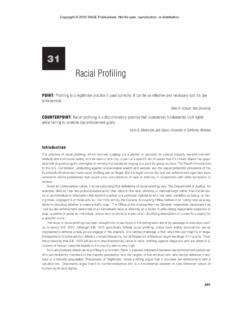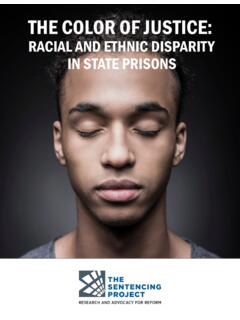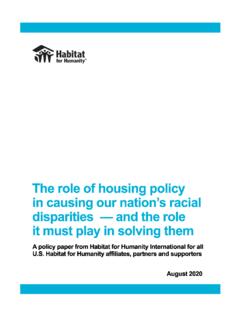Transcription of Poverty: Facts, Causes and Consequences
1 poverty : Facts, Causes and ConsequencesJoe TiaoLecture, Kansas State UniversityHilary HoynesUniversity of California, DavisApril 2012 In 2010, more than 1 in 5 children lived in poverty and percent of all persons were poor. Government spending on anti- poverty programs includes $30 b. on TANF, $51 b. on the EITC, and $50 b. on Food Stamps. In this talk, I discuss what we know about the Causes of poverty and its Consequences for children and How do we define poverty ? Facts: poverty in the Impacts of poverty on children and families The Causes of poverty and how government policies can help3 How do we define poverty ? Facts: poverty in the Impacts of poverty on children and families The Causes of poverty and how government policies can help4 What is the Official poverty Measure? A family is poor if their family income is less than the federal poverty threshold poverty lines vary by family size and are adjusted for changes in prices each year Based on the cost of food in the 1960s (multby 3) poverty is a family concept all persons in the same family have the same poverty statusPoverty Thresholds by Family Type, 20101 parent, 1 child$15,0301 parent, 2 children$17,5682 parents, 2 children$22,1135By comparison, 2010 median family income was $49, about official poverty measure Income measure is pre-tax family income; includes only cash income Does not include Food Stamps (SNAP) or Earned Income Tax Credit Not adjusted for work-related expenses Not adjusted for regional variation in costs of living ( , housing) Definition of poverty has not changed since measure developed in early 1960s Recent Supplemental poverty Measure released by Census.
2 Addresses these concerns6 How do we define poverty ? Facts: poverty in the Impacts of poverty on children and families The Causes of poverty and how government policies can help780510152025301960196519701975198019 8519901995200020052010 poverty Rate, All PersonsIn 2010, 46 millionpersons or of the population was poorChildren have the highest poverty rates90%10%20%30%40%50%60%Age < 18 Age 18-64 Age 65+ poverty RateShare of Poor100%10%20%30%40%50%60%Age < 18 Age 18-64 Age 65+ poverty RateShare of PoorNote the differences between the poverty rate and the group s share of all success in improving poverty varies by age1101020304019601965197019751980198519 901995200020052010 poverty Rate, By AgeChildrenAge 18-64 Age 65+Latinos and African Americans have high poverty rates120%10%20%30%40%50%WhiteBlackAsianH ispanicPoverty RateShare of PoorFemale headed households have high poverty rates130%10%20%30%40%50%60%Married-Coupl e FamiliesSingle with kidsSingle without kidsPoverty RateShare of PoorPoverty dramatically declines with education1424%12%8%4%18%16%12%5%0%5%10%1 5%20%25%30%Less than highschool graduateHigh schoolgraduate(includesequivalency)Some college,associate'sdegreeBachelor's degreeor higherPoverty RateShare of PoorNon-citizens have higher poverty rates150%10%20%30%Native bornForeign born, Naturalized CitizenForeign born, Not a CitizenPoverty Rate How do we define poverty ?
3 Facts: poverty in the Impacts of poverty on children and families The Causes of poverty and how government policies can help16 poverty is measured and watched by virtually all developed countries. It is an important indicator of economic well-being In the , poverty is associated with many adverse outcomes17 Children who grow up poor are more likely to Not attend preschool Perform worse in school Drop out of high school, have lower educational attainment (Girls) Have a teen birth (Boys) Be incarcerated Live in poverty as adults Receive government assistance as adults Have connection to the child welfare system Have worse health and shorter life expectancy18 The challenge for social science research is in role played by poverty in these policies can improve outcomes. How do we define poverty ? Facts: poverty in the Impacts of poverty on children and families The Causes of poverty and how government policies can help20(1) The Labor Market Most poor families contain workers poverty is very closely tied to the conditions of the labor market Availability of jobs Wages paid at those jobs21 poverty varies with job availability2205101520253019601965197019 751980198519901995200020052010 poverty Rate, All Persons15percent poor in recessions: 1983, 1993, 2010 poverty increasedmore in states that experienced larger increasesin unemployment23 ALAKAZARCACOCTDEFLGAHIIDILINIAKSKYMEMDMA MIMNMSMOMTNENVNHNJNMNYNCNDOHOKORPARISCSD TNTXUTVTVAWAWVWIWY-20246 Change in poverty Rate 2000-2008-20246 Change in Unemployment Rate 2000-2008 Earnings is a large share of income for the poor240102030405060 Earned incomeCash Welfare (AFDC, TANF)Food StampsUnemp.
4 , Worker's Comp., Veteran's PaymentsChild Support, AlimonyCash Welfare for Disabled, SSIO fficial PovertyExtreme poverty Importance of wages paid at those jobs Wages and earnings for less skilled workers is a key determinant of poverty What has happened to earnings for less skilled workers?25 Wages for lower education groups have been fallingReal Median Earnings by Education26 growth in family income at the bottom of the distribution (and significant growth at the top)27-40-200204060801969197419791984198 919941999200490th75thMedian25th10thSourc e: Debbie Reed, PPICHow does this relate to the current attention to the 99% (and the 1%)?280%5%10%15%20%25%191319181923192819 3319381943194819531958196319681973197819 8319881993199820032008 Share of total income accruing to each groupTop 1% (incomes above $352,000 in 2010)Top 1% (incomes above $352,000 in 2010)The top 1%: Share of total US income29 Source: Emmanuel Saez, UC Berkeley0%5%10%15%20%25%1913191819231928 1933193819431948195319581963196819731978 198319881993199820032008 Share of total income accruing to each groupTop 1% (incomes above $352,000 in 2010)Top 5-1% (incomes between $150,000 and $352,000)Top 10-5% (incomes between $108,000 and $150,000)Share of total income to top decile30 Source: Emmanuel Saez, UC Berkeley31(2) Economic Growth (?)
5 32 poverty persists despite economic growth0510152025301960196519701975198019 8519901995200020052010 poverty Rate, All Persons15percent poor in recessions: 1983, 1993, 2010 poverty persists despite economic growth0510152025301960196519701975198019 8519901995200020052010 poverty Rate, All Persons15percent poor in recessions: 1983, 1993, 2010010203040501960196519701975198019851 9901995200020052010 GDP per capita (thousands of 2005 $)Strong GDP growth 1983-201063% increase These figures show that economic growth does not necessarily translate into reductions in poverty 35 Government policies that reduce povertyor don t(and why)36 The Social Safety Net for Families TANF: cash welfare Food Stamps (now SNAP): vouchers for food Earned Income Tax Credit: tax-subsidy for low earners Medicaid: health insurance Subsidized housing WIC, free or reduced price lunch Unemployment insurance (not limited to low income families)Recent changes in the Safety Net The safety net for low income families has dramatically changed: More assistance through the federal taxes (the Earned Income Tax Credit) More assistance through in-kind support (Food stamps, Medicaid/SCHIP) Less assistance through traditional cash welfare Much of my research focuses on estimating the effects of the safety net on low income and Near Cash Safety Net Spending per Capita, 2009$05010015020025019801985199019952000 20052010 Per Capita Real ExpendituresContractionsAFDC/TANF Cash Grants Per CapitaFood Stamp Total Expenditures Per CapitaEITC Total Expenditures Per CapitaFederal welfare reformGovernment policies can help Case Study: Contrast two policies aimed at reducing poverty The success story.
6 Earned Income Tax Credit The contrasting program: Welfare The key explanation EITC targets those in-work and welfare targets those out-of-work40 The Earned Income Tax Credit Refundable tax credit for working, low-income taxpayers with children (single and married) [Much smaller credit for childless] No credit if no family earnings EITC acts to supplement earnings. Maximum credit for 2010: $3050 for one-child families $5036 for families with two or more children41 KEY: Maximum EITC credit helps families near poverty threshold!42$0$1,000$2,000$3,000$4,000$5 ,000$0$5,000$10,000$15,000$20,000$25,000 $30,000$35,000$40,000 Earned Income 2006$Credit Amount (2006$)One ChildTwo or more ChildrenPhase inRegionPhase outRegionFlatRegionHow the EITC reduces design feature of EITC (and what distinguishes it from traditional income support programs) is that eligibility requires earned income. The EITC transfers income to low income families with children WHILE encouraging generosity of the EITC increased substantially with tax reforms in 1986, 1990, and 1993.
7 43 Illustrating how EITC encourages work and reduces poverty44$0$10,000$20,000$30,000$40,000$ 0$10,000$20,000$30,000$40,000 poverty Line, Family of ThreeEarnings Family earningsFamily after-tax and transfer incomeIllustrating how EITC encourages work and reduces poverty45$0$10,000$20,000$30,000$40,000$ 0$10,000$20,000$30,000$40,000 poverty Line, Family of ThreeEarnings + EITCE arnings So, the EITC has the potential to increase incomes and reduce poverty through two channels: The EITC represents an increase in income for the family The EITC provides incentives to enter work, and thus increase earnings which increases family cash assistance: welfare programs47 Cash Welfare Programs (TANF)Income support (welfare) programs are unlikely to affect poverty rates for two levels are low, unlikely to increase a household s income over the poverty are targeted on those out of work; thereby discouraging work rather than encouraging it.
8 [This does not mean the program is not important or useful. Rather that it simply should not affect poverty rates. Should affect extreme poverty . ] 48 Illustrating why TANF is unlikely to affect poverty49$0$10,000$20,000$30,000$40,000$ 0$10,000$20,000$30,000$40,000 poverty Line, Family of ThreeEarnings Family earningsFamily after-tax and transfer incomeIllustrating why TANF is unlikely to affect poverty50$0$10,000$20,000$30,000$40,000$ 0$10,000$20,000$30,000$40,000 poverty Line, Family of ThreeEarnings + TANFE arnings One coulduse TANF to reduce poverty , but funding would have to be about four times the current funding51$0$10,000$20,000$30,000$40,000$ 0$10,000$20,000$30,000$40,000 poverty Line, Family of ThreeEarnings + TANFE arnings What we do know, however, is that the combination of welfare reform and the expansion of the EITC led to large increasesin employment among female-headed families in the late 1990s.
9 These increases in employment have the potential to reduce employed at all last yearSingle, No ChildrenMarried, No ChildrenSingle, ChildrenMarried, ChildrenOn the eve of welfare reform and EITC increases, much attention is given to the low employment rates of single of Women Working (by Marital Status and Children)Percent of Women Working (by Marital Status and Children)5460%65%70%75%80%85%90%95%100%1 9831986198919921995199820012004 Percent employed at all last yearSingle, No ChildrenMarried, No ChildrenSingle, ChildrenMarried, ChildrenBeginning in 1992 dramatic increases in employment for single mothers, with little change for other womenEmployment rates for the single moms have fallen since their peak in 2000 but are still historically high5550%60%70%80%90%100%198019851990199 520002005 Single no childrenSingle with childrenMarried with childrenMore on what the government policies can do56 Food Stamps (SNAP) has become the fundamental safety net program Eligibility universal Reaches working poor and nonworking poor Program has been VERY responsive in the current recession57 Food Stamps and TANF in the Great RecessionWhich is acting as the safety net?
10 5805010015020025019801985199019952000200 52010 Per Capita Real ExpendituresContractionsAFDC/TANF Cash Grants Per CapitaFood Stamp Total Expenditures Per CapitaEITC Total Expenditures Per CapitaFederal welfare reformFood Stamps and TANF in the Great RecessionWhich is acting as the safety net? :12007:72008:12008:72009:12009:72010:1 Monthly Unemployed and Program Caseloads Unemployed PersonsTANF CasesFSP CasesRecession ends June 2009 Food Stamps and TANF in the Great RecessionWhich is acting as the safety net?60-20020406080 Percent Change in FSP Caseload per capita02468 Change in unemployment rateFood Stamps and Unemployment RateChange between 2007 and 2009-40-2002040 Percent change in AFDC/TANF caseload per capita02468 Change in unemployment rateCash Welfare (TANF) and Unemployment RateChange between 2007 and 2009 So the safety net can reduce poverty . How are we doing? But .. The success of the EITC and SNAP is not measured by official poverty statistics Remember our definition of poverty ?








